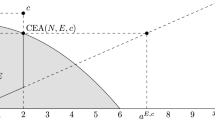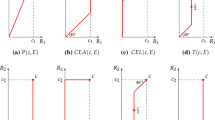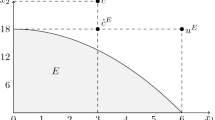Abstract
This paper analyzes a family of rules for bankruptcy problems that generalizes the so-called reverse Talmud rule and encompasses both the constrained equal-awards rule and the constrained equal-losses rule. The family, introduced by van den Brink et al. (Eur J Oper Res 228:413–417, 2013), is a counterpart to the so-called TAL-family of rules, introduced and studied by Moreno-Ternero and Villar (Soc Choice Welf 27:231–249, 2006a), and it is included within the so-called CIC-family of rules introduced by Thomson (Soc Choice Welf 31:667–692, 2008). We provide a systematic study of the structural properties of the rules within the family, as well as its connections with the existing related literature.

Similar content being viewed by others
Notes
More recently, Huijink et al. (2015) have given an alternative definition of the rules in such a family, as claim-and-right rules, which give a specific interpretation to the concept of baselines formalized earlier by Hougaard et al. (2012, 2013a, b). See also Pulido et al. (2002, 2008), Bergantiños and Lorenzo (2008) and Timoner and Izquierdo (2016) for related notions.
For each \(N\in {\mathcal {N}}\), each \(M\subseteq N\), and each \(z\in {\mathbb {R}}^{n}\), let \(z_{M}\equiv (z_{i})_{i\in M}\). For each \(i\in N\), let \(z_{-i}\equiv z_{N{\setminus }\{i\}}\).
It is not difficult to show directly, nonetheless, that the rules within the family indeed satisfy the three properties.
We say that a property \(P^{*}\) is the dual of property P if, for each rule R, it holds that R satisfies P if and only if \(R^{*}\) satisfies \(P^{*}\). A property is self-dual if it coincides with its dual.
These two axioms were studied first by Curiel et al. (1987).
The property was introduced by Moreno-Ternero and Villar (2004) under the name of securement.
The proportional rule is the rule that selects, for each \( (N,c,E)\in {\mathcal {D}}\), the vector \((\frac{E}{C}\cdot c_{i})_{i\in N}\). Observe that, for a given problem \(( N,c,E) \in {\mathcal {D}}\), the rule \(\textit{RT}^{\theta }\) within the reverse TAL-family, where \(\theta =\frac{E}{C}\), yields an allocation \(\textit{RT}^{E/C}(N,c,E)\) that coincides with the allocation provided by the proportional rule to this problem. Yet, there is no \(\theta \) for which \(\textit{RT}^{\theta }\) is the proportional rule (i.e., the proportional rule is not a member of the reverse TAL-family).
The notions of sustainability and independence of residual claims are referred as conditional full compensation and conditional null compensation, respectively, by Thomson (2003).
He also considers the larger family arising from this one when dropping equal treatment of equals, as well as the corresponding dual family.
Likewise, the intersection between the dual family and the reverse TAL-family only consists of the constrained equal-awards rule.
More generally, and as shown by Huijink et al. (2015), the baselines first extension operator allows to recover the whole family of CIC rules from the constrained equal-awards rule, provided baselines are generic, and not necessarily a proportion of claims.
Similarly, the rules within the TAL-family can be characterized by parametrizing lower bounds properties (e.g., Moreno-Ternero and Villar 2006a). More recently, Arin et al. (2015) have also characterized the reverse TAL-family resorting instead to parametrized versions of additive properties, which were not considered here.
Note that \((1-c_{i})+\lambda \ge \theta c_{j}+(1-\theta )c_{i}\).
Note that order preservation and consistency are self-dual properties.
References
Arin, J., Benito-Ostolaza, J., & Inarra, E. (2015). The RTAL-family of rules for bankruptcy problems: A characterization. Mimeo: University of the Basque Country.
Aumann, R. J., & Maschler, M. (1985). Game theoretic analysis of a bankruptcy problem from the Talmud. Journal of Economic Theory, 36, 195–213.
Bergantiños, G., & Lorenzo, L. (2008). The equal award principle in problems with constraints and claims. European Journal of Operational Research, 1881, 224–239.
van den Brink, R., Funaki, Y., & van der Laan, G. (2013). Characterization of the reverse Talmud bankruptcy rule by exemption and exclusion properties. European Journal of Operational Research, 228, 413–417.
Casas-Méndez, B., Fragnelli, V., & García-Jurado, I. (2011). Weighted bankruptcy rules and the museum pass problem. European Journal of Operational Research, 215, 161–168.
Chambers, C. P. (2005). Asymmetric rules for claims problems without homogeneity. Games and Economic Behavior, 54, 241–260.
Chambers, C. P., & Moreno-Ternero, J. D. (2017). Taxation and poverty. Social Choice and Welfare, 48, 153–175.
Chambers, C. P., & Thomson, W. (2002). Group order preservation and the proportional rule for bankruptcy problems. Mathematical Social Sciences, 44, 235–252.
Chun, Y. (1999). Equivalence of axioms for bankruptcy problems. International Journal of Game Theory, 28, 511–520.
Chun, Y., Schummer, J., & Thomson, W. (2001). Constrained egalitarianism: A new solution for claims problems. Seoul Journal of Economics, 14, 269–297.
Curiel, I., Maschler, M., & Tijs, S. (1987). Bankruptcy games. Zeitschrift für Operations Research, 31, A143–A159.
Flores-Szwagrzak, K. (2015). Priority classes and weighted constrained equal-awards rules for the claims problem. Journal of Economic Theory, 160, 36–45.
Giménez-Gómez, J. M., & Osorio, A. (2015). Why and how to differentiate in claims problems? An axiomatic approach. European Journal of Operational Research, 241, 842–850.
Giménez-Gómez, J. M., & Peris, J. E. (2014). A proportional approach to claims problems with a guaranteed minimum. European Journal of Operational Research, 232, 109–116.
Harless, P. (2017). Endowment additivity and the weighted proportional rules for adjudicating conflicting claims. Economic Theory, 63, 755–781.
Herrero, C., & Villar, A. (2002). Sustainability in bankruptcy problems. TOP, 10, 261–273.
Hougaard, J. L., Moreno-Ternero, J. D., & Østerdal, L. P. (2012). A unifying framework for the problem of adjudicating conflicting claims. Journal of Mathematical Economics, 48, 107–114.
Hougaard, J. L., Moreno-Ternero, J. D., & Østerdal, L. P. (2013a). Rationing in the presence of baselines. Social Choice and Welfare, 40, 1047–1066.
Hougaard, J. L., Moreno-Ternero, J. D., & Østerdal, L. P. (2013b). Rationing with baselines: The composition extension operator. Annals of Operations Research, 211, 179–191.
Huijink, S., Borm, P. E. M., Kleppe, J., & Reijnierse, J. H. (2015). Bankruptcy and the per capita nucleolus: The claim-and-right rules family. Mathematical Social Sciences, 77, 15–31.
Ju, B.-G., & Moreno-Ternero, J. D. (2017). Fair allocation of disputed properties. International Economic Review, 58(4).
Moreno-Ternero, J. D. (2007). Bankruptcy rules and coalitional manipulation. International Game Theory Review, 9, 105–118.
Moreno-Ternero, J. D. (2011a). Voting over piece-wise linear tax rules. Journal of Mathematical Economics, 47, 29–36.
Moreno-Ternero, J. D. (2011b). A coalitional procedure leading to a family of bankruptcy rules. Operations Research Letters, 39, 1–3.
Moreno-Ternero, J. D., & Roemer, J. (2006). Impartiality, solidarity, and priority in the theory of justice. Econometrica, 74, 1419–1427.
Moreno-Ternero, J. D., & Roemer, J. (2012). A common ground for resource and welfare egalitarianism. Games and Economic Behavior, 75, 832–841.
Moreno-Ternero, J. D., & Villar, A. (2004). The Talmud rule and the securement of agents’ awards. Mathematical Social Sciences, 47, 245–257.
Moreno-Ternero, J. D., & Villar, A. (2006a). The TAL-family of rules for bankruptcy problems. Social Choice and Welfare, 27, 231–249.
Moreno-Ternero, J. D., & Villar, A. (2006b). On the relative equitability of a family of taxation rules. Journal of Public Economic Theory, 8, 283–291.
Moulin, H. (1987). Equal or proportional division of a surplus, and other methods. International Journal of Game Theory, 16, 161–186.
Moulin, H. (2000). Priority rules and other asymmetric rationing methods. Econometrica, 68, 643–684.
O’Neill, B. (1982). A problem of rights arbitration from the Talmud. Mathematical Social Sciences, 2, 345–371.
Pulido, M., Sanchez-Soriano, J., & Llorca, N. (2002). Game theory techniques for university management: An extended bankruptcy model. Annals of Operations Research, 109, 129–142.
Pulido, M., Borm, P., Hendricx, R., Llorca, N., & Sanchez-Soriano, J. (2008). Compromise solutions for bankruptcy situations with references. Annals of Operations Research, 158, 133–141.
Thomson, W. (2003). Axiomatic and game-theoretic analysis of bankruptcy and taxation problems: A survey. Mathematical Social Sciences, 45, 249–297.
Thomson, W. (2008). Two families of rules for the adjudication of conflicting claims. Social Choice and Welfare, 31, 667–692.
Thomson, W. (2013). The theory of fair allocation. Princeton: Princeton University Press (forthcoming).
Thomson, W. (2015a). Axiomatic and game-theoretic analysis of bankruptcy and taxation problems: An update. Mathematical Social Sciences, 74, 41–59.
Thomson, W. (2015b). For claims problems, a compromise between the constrained equal awards and proportional rules. Economic Theory, 60, 452–495.
Thomson, W. (2017). How to divide when there isn’t enough: From the Talmud to game theory. Econometric Society Monograph. Cambridge, MA: Cambridge University Press.
Timoner, P., & Izquierdo, J. M. (2016). Rationing problems with ex-ante conditions. Mathematical Social Sciences, 79, 46–52.
Yeh, C.-H. (2006). Protective properties and the constrained equal-awards rule for claims problems: A note. Social Choice and Welfare, 27, 221–230.
Young, H. P. (1987). On dividing an amount according to individual claims or liabilities. Mathematics of Operations Research, 12, 398–414.
Author information
Authors and Affiliations
Corresponding author
Additional information
We thank an anonymous referee for helpful comments and suggestions. Moreno-Ternero acknowledges financial support from the Spanish Ministry of Economy and Competitiveness (ECO2014-57413-P).
Appendix: Proofs of the results
Appendix: Proofs of the results
In what follows, we omit all straightforward steps in the proofs.
Proof of Proposition 2
As all rules within the reverse TAL-family are parametric, we obtain, following Young (1987), that all rules within the reverse TAL-family satisfy equal treatment of equals, continuity, and consistency.Footnote 18 By Lemma 3 in Chambers and Thomson (2002) they also satisfy anonymity.
As for order preservation, let \(\theta \in [ 0,1] \) and \(( N,c,E) \in {\mathcal {D}}\) be given. We distinguish two cases.
Case 1 \(E\le \theta C\).
In this case, \(\textit{RT}_{i}^{\theta }( N,c,E) =\max \{ \theta c_{i}-\lambda ,0 \}\), for each \(i\in N\). Let \(i,j\in N\) be such that \( c_{i}\ge c_{j}\). Then, \(\textit{RT}_{i}^{\theta }( N,c,E) \ge \textit{RT}_{j}^{\theta }( N,c,E) \). Now, suppose that \( \lambda <\theta c_{j}\le \theta c_{i}\). Then, \(c_{i}-\textit{RT}_{i}^{\theta }( N,c,E) =c_{i}-(\theta c_{i}-\lambda ) \ge c_{j}-(\theta c_{j}-\lambda ) =c_{j}-\textit{RT}_{j}^{\theta }( N,c,E) \). On the other hand, if \(\theta c_{i}\ge \lambda \ge \theta c_{j}\), then \(c_{i}-\textit{RT}_{i}^{\theta }( N,c,E) =(1-c_{i})+\lambda \ge c_{j}=c_{j}-\textit{RT}_{j}^{\theta }( N,c,E) \).Footnote 19 Finally, if \(\lambda >\theta c_{i}\) then \(c_{i}-\textit{RT}_{i}^{\theta }( N,c,E) =c_{i}\ge c_{j}=c_{j}-\textit{RT}_{j}^{\theta }( N,c,E) \).
Case 2 \(E\ge \theta C\).
In this case, \(\textit{RT}_{i}^{\theta }( N,c,E) =\theta c_{i}+\min \{ (1-\theta ) c_{i}, \mu \} \), for each \(i\in N\). Let \(i,j\in N\) be such that \( c_{i}\ge c_{j}\). Then, \(\textit{RT}_{i}^{\theta }( N,c,E) \ge \textit{RT}_{j}^{\theta }( N,c,E) \). Now, suppose that \( \mu <(1-\theta )c_{j} \le (1-\theta )c_i\). In this case, \(c_{i}-\textit{RT}_{i}^{\theta }( N,c,E) =(1-\theta )c_{i}-\mu \ge (1-\theta )c_{j}-\mu =c_{j}-\textit{RT}_{j}^{\theta }( N,c,E) \). On the other hand, if \((1-\theta )c_{i}\ge \mu \ge (1-\theta )c_{j}\) then \( c_{i}-\textit{RT}_{i}^{\theta }( N,c,E) =(1-\theta )c_{i}-\mu \ge 0=c_{j}-\textit{RT}_{j}^{\theta }( N,c,E) \). Finally, if \(\mu >(1-\theta )c_{i}\), then \(c_{i}-\textit{RT}_{i}^{\theta }( N,c,E) =0=c_{j}-\textit{RT}_{j}^{\theta }( N,c,E) \).
Finally, we turn to scale invariance. Let \(( N,c,E) \in {\mathcal {D}}\) be given. We distinguish three cases:
Case 1 \(E<\theta C\).
As \(\alpha E<\alpha \theta C\) for each \(\alpha >0,\) it follows that \( \textit{RT}_{i}^{\theta }( N,c,E) =\max \{ \theta c_{i}-\lambda ,0 \}\), and \(\textit{RT}_{i}^{\theta }( N,\alpha c,\alpha E) =\max \{ \theta \alpha c_{i}-\lambda ^{\prime },0 \}\), for each \(i\in N\), where \(\lambda \) and \(\lambda ^{\prime }\) are such that \(\sum _{i\in N}{} \textit{RT}_{i}^{\theta }( N,c,E) =E\) and \(\sum _{i\in N}{} \textit{RT}_{i}^{\theta }( N,\alpha c,\alpha E) =\alpha E\), respectively. Now, there exists \(\overline{\lambda }>0\), such that \(\lambda ^{\prime }=\alpha \overline{\lambda }\). Thus, \(\max \{ \theta \alpha c_{i}-\lambda ^{\prime },0\} =\alpha \max \{ \theta c_{i}-\overline{\lambda }, 0 \} \). Assume, without loss of generality, that \(c_{n}=\max _{i\in N}\{c_{i}\}.\) Then, the function \( H^{\theta }:[ 0,\theta c_{n}] \rightarrow {\mathbb {R}}_{+}\) such that \( H^{\theta }(\lambda )=\sum _{i\in N}\max \{ \theta c_{i}-\lambda ,0 \}\) is piecewise linear and strictly increasing. Moreover, its image corresponds to \([0,\theta C]\). Thus, for each \(E\in [0,\theta C)\) there exists a unique \(\lambda _{0}\) such that \(H^{\theta }(\lambda _{0})=E\) . This implies \(\lambda =\overline{\lambda }=\lambda _{0}\), and therefore, \( \textit{RT}_{i}^{\theta }( N,\alpha c,\alpha E) =\alpha \textit{RT}_{i}^{\theta }( N,c,E) \), for each \(i\in N\).
Case 2 \(E>\theta C\).
As \(\alpha E>\alpha \theta C\) for each \(\alpha >0\), we have \(\textit{RT}_{i}^{\theta }( N,c,E) =\theta c_{i}+\min \{ (1-\theta ) c_{i}, \mu \} \), and \( \textit{RT}_{i}^{\theta }( N,\alpha c,\alpha E) =\theta \alpha c_{i}+\min \{ (1-\theta ) \alpha c_{i}, \mu ^{\prime } \}\), for each \(i\in N\), where \( \mu \) and \(\mu ^{\prime }\) are such that \(\sum _{i\in N}{} \textit{RT}_{i}^{\theta }( N,c,E) =E\) and \(\sum _{i\in N}{} \textit{RT}_{i}^{\theta }( N,\alpha c,\alpha E) =\alpha E\), respectively. Now, there exists \(\overline{\mu }>0\), such that \(\mu ^{\prime }=\alpha \overline{\mu }\). Thus, \(\alpha \theta c_{i}+\min \{ (1-\theta ) \alpha c_{i}, \mu ^{\prime } \} =\alpha (\theta c_{i}+\min \{ (1-\theta ) c_{i}, \overline{\mu } \})\). Take again \(c_{n}=\max _{i\in N}\{c_{i}\}.\) Then, the function \( H^{\theta }:[ 0,( 1-\theta ) c_{n}] \rightarrow {\mathbb {R}}_{+}\) such that \(H^{\theta }(\mu )=\sum _{i\in N}\min \{ (1-\theta ) c_{i},\mu \} \) is piecewise linear and strictly increasing. Moreover, its image corresponds to \([\theta C,C]\). Thus, for each \(E\in (\theta C,C]\) there exists a unique \(\mu _{0}\) such that \(H^{\theta }(\mu _{0})=E\). This implies \(\mu =\overline{\mu }=\mu _{0}\), and, therefore, \( \textit{RT}_{i}^{\theta }( N,\alpha c,\alpha E) =\alpha \textit{RT}_{i}^{\theta }( N,c,E) \), for each \(i\in N\).
Case 3 \(E=\theta C\).
Then \(\textit{RT}_{i}^{\theta }(N,c,E) =\theta c_{i}\) for each \(i\in N\) and therefore, the property trivially holds. \(\square \)
Proof of Proposition 3
All rules within the reverse TAL-family satisfy resource monotonicity, claims monotonicity, and population monotonicity. Thus, by Proposition 1, they all satisfy linked claim-resource monotonicity (the dual property of claims monotonicity) and linked resource-population monotonicity (the dual of population monotonicity). Finally, Chun (1999) shows that resource monotonicity and consistency together imply resource-and-population uniformity. As, by Proposition 2, all rules within the reverse TAL-family are consistent, it follows that they all satisfy resource-and-population uniformity. \(\square \)
Proof of Proposition 4
By duality, it suffices to show one of the statements. It is well known that \(\textit{RT}^{0}=A\) satisfies claims truncation invariance whereas \(\textit{RT}^{1}=L\) does not. Let us see that no intermediate rule within the reverse TAL-family satisfies it either. Let \(\theta \in (0,1)\) and consider the two-claimant problem \(B=(\{1,2\},( E,\frac{E}{\theta }), E)\). Then, \(\textit{RT}^{\theta }( B) =(\frac{\theta E}{2},E-\frac{\theta E}{2})\). The associated problem in which claims are truncated is \((\{1,2\},( E,E) ,E)\), whose solution is \((\frac{E}{2 },\frac{E}{2})\). Therefore, \(\textit{RT}^{\theta }( \{1,2\},c,E) \ne \textit{RT}^{\theta }( \{1,2\},t(N,E,c),E). \) \(\square \)
Proof of Proposition 5
By duality, it suffices to show one of the statements. It is well known that \(\textit{RT}^{0}=A\) satisfies average truncated lower bound on awards whereas \(\textit{RT}^{1}=L\) does not (e.g., Moreno-Ternero and Villar 2004). Let us see that no intermediate rule within the reverse TAL-family satisfies it either. Let \(\theta \in (0,1)\) and consider the two-claimant problem \(B=(\{1,2\},( E,\frac{E}{\theta }),E )\). Then, \(\textit{RT}^{\theta }( B) =(\frac{\theta E}{2},E-\frac{\theta E}{2})\ne (\frac{E}{2},\frac{E}{2})\). On the other hand, assume, by contradiction, that \(\textit{RT}^{\theta }\) satisfies average truncated lower bound on awards, for some \(\theta \in (0,1)\). Then, \(\textit{RT}^{\theta }( B) =(\frac{E}{2},\frac{E}{2})\), which represents a contradiction. \(\square \)
Proof of Proposition 6
-
(i)
The rules \(\textit{RT}^{1}=L\) and \(\textit{RT}^{0}=A\) satisfy composition up (e.g., Moulin 2000). Let us see that there is no other rule within the reverse TAL-family for which this happens. Let \(\theta \in (0,1)\) be given. Consider the two-claimant problem
$$\begin{aligned} (N,c,E)=\left( \{1,2\},\left( \frac{1}{3\theta },\frac{1}{\theta }\right) ,1 \right) , \end{aligned}$$and let \(E_{1}=\frac{1}{2}=E_{2}\). Then, \(E_{1}<E=1<\frac{1}{3}+1=\theta \cdot ( c_{1}+c_{2}) \). Thus, \(\textit{RT}^{\theta }(N,c,E)=L(N,\theta c,E)=( \frac{1}{6},\frac{5}{6}) \) and \(\textit{RT}^{\theta }( N,c,E_{1}) =L(N,\theta c, E_{1})=( 0,\frac{1}{2}) \).
Let \(c^{\prime }=c-\textit{RT}^{\theta }( N,c,E_{1}) =( \frac{1}{ 3\theta },\frac{1}{\theta }-\frac{1}{2}) \). Then, \(E_{2}-\theta \cdot ( c_{1}^{\prime }+c_{2}^{\prime }) =\frac{1}{2}- ( \frac{8-3\theta }{6})<0\), so that
$$\begin{aligned} \textit{RT}^{\theta }\left( N,c^{\prime },E_{2}\right) =L\left( N,\theta c^{\prime },E_{2}\right) =\left\{ \begin{array}{ll} \left( 0,\frac{1}{2}\right) &{}\quad \hbox {if}\, \theta \le \frac{1}{3} \\ \left( \frac{1}{3}-\frac{5-3\theta }{12},\frac{2-\theta }{2}-\frac{5-3\theta }{12}\right) &{}\quad \hbox {if}\, \theta >\frac{1}{3} \end{array} \right. . \end{aligned}$$Thus, \(\textit{RT}^{\theta }( N,c,E) \ne \textit{RT}^{\theta }( N,c,E_{1}) +\textit{RT}^{\theta }( N,c^{\prime },E_{2}) \) for each \( \theta \in (0,1)\).
-
(ii)
Both A and L satisfy composition down (e.g., Moulin 2000). Now, suppose that there exists some \(\theta \in (0,1)\) such that \(\textit{RT}^{{}\theta }\) satisfies composition down. Then \(\textit{RT}^{1-\theta }\), the dual rule of \(\textit{RT}^{\theta }\), should satisfy composition up, which contradicts part (i) of this theorem. \(\square \)
Proof of Proposition 7
Yeh (2006) shows that the constrained equal-awards rule is the only rule that satisfies sustainability and claims monotonicity. By duality, the constrained equal losses rule is the only rule that satisfies independence of residual claims and linked claim-resource monotonicity. Yeh (2006) also shows that the constrained equal-awards rule is the only rule satisfying exemption, order preservation, and consistency. By duality, the constrained equal-losses rule is the only rule satisfying exclusion, order preservation and consistency.Footnote 20 As all rules within the reverse TAL-family are consistent and order preserving (Proposition 2), and satisfy claims monotonicity and linked claim-resource monotonicity (Proposition 3) the proofs of all the statements follow from Yeh’s results and duality. \(\square \)
Rights and permissions
About this article
Cite this article
van den Brink, R., Moreno-Ternero, J.D. The reverse TAL-family of rules for bankruptcy problems. Ann Oper Res 254, 449–465 (2017). https://doi.org/10.1007/s10479-017-2455-x
Published:
Issue Date:
DOI: https://doi.org/10.1007/s10479-017-2455-x




